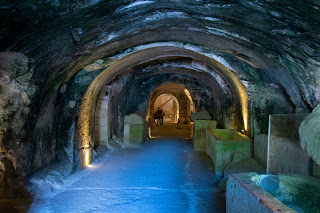Welcome back to Part 2 about Beit She'arim!
As I said in the last post, Beit She'arim was a place I'd never heard before. That's because it wasn't mentioned in the Bible. It's an important place in Israel's history from the 1st century AD. There are the remains of a Roman-era Jewish town, and, what we'll explore in this post, the necropolis—a series of rock-cut tombs and caves carved into stone.According to Wikipedia, Beit She'arim became the popular place for burial around 135 AD, when Jews were barred from Jerusalem and could no longer be buried on the Mount of Olives. The Sanhedrin ended up settling in the town of Beit She'arim before moving on to Tiberias, so many famous rabbis were buried here.
In all, there are more than 30 burial caves. Some have been excavated, and some haven't. Some were ravaged by grave robbers, so much of the contents were destroyed. But there still remains some incredible historical detail.
A UNESCO Heritage Site, Wikipedia says that "though only a portion of the necropolis has been excavated, it has been likened to a book inscribed in stone. Its catacombs, mausoleums, and sarcophagi are adorned with elaborate symbols and figures as well as an impressive quantity of incised and painted inscriptions in Hebrew, Aramaic, Palmyrene, and Greek, documenting two centuries of historical and cultural achievement. The wealth of artistic adornments contained in this, the most ancient extensive Jewish cemetery in the world, is unparalleled anywhere."














No comments:
Post a Comment